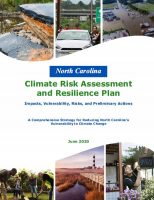
Access to grants for local governments, tools for better planning and more local participation and training are among the strategies in a multiagency push that’s the next step toward incorporating climate science and resiliency planning throughout North Carolina.
 Thursday, the state Climate Change Interagency Council, which includes all cabinet-level agencies, wrapped up its review of the recently issued North Carolina Climate Risk Assessment and Resilience Plan. The report includes an in-depth, region-by-region look at the progression to a warmer, wetter climate and what that means for communities throughout the state.
Thursday, the state Climate Change Interagency Council, which includes all cabinet-level agencies, wrapped up its review of the recently issued North Carolina Climate Risk Assessment and Resilience Plan. The report includes an in-depth, region-by-region look at the progression to a warmer, wetter climate and what that means for communities throughout the state.
Supporter Spotlight
The council also got a look at what’s ahead in implementing on a broad scale the resiliency called for in the report.
“Producing a plan is not as important as continuing to take action as we move forward,” Jessica Whitehead, the state’s chief resilience officer, told council members as she laid out the path ahead.
Whitehead, of the North Carolina Office of Recovery and Resiliency, said establishing guiding principles that could be applied in different areas and situations was key.
“We know it’s a challenge to define what climate resilience looks like from Murphy to Manteo, and so it’s stepping back and looking at what applies no matter what your place is, no matter what your agency is, no matter what your biggest climate vulnerabilities are,” she said.
The principles outlined in a path forward include acting quickly and decisively on most harmful threats as a long-term approach that includes collaboration on equitable, community-based decisions.
Supporter Spotlight
“We know and we’ve heard very strongly that we need to have resilience training for local communities. A lot of people have heard the word ‘resilience,’ but they don’t know what it means in the context of their everyday work,” Whitehead said.
Although the word is often associated with recent disasters, Whitehead said climate resiliency is not all about disaster response.
“Disasters are an important part of climate change, but they are not the only long-term climate hazards,” she said, adding that sea level rise, droughts and extreme heat will also have an impact on the way people live. “These are long-term issues that happen over decades, and we know they need long-term, equitable solutions.”
Building local expertise in resiliency planning, including navigating the complexities of study requirements and grant programs, has been a focus for Amanda Martin, deputy resiliency officer, who has been working on NCORR’s Resilient Communities Program aimed at building local expertise and resources. Martin said most of the funding for resiliency is dedicated to infrastructure and there isn’t enough funding available for training at the local level.“There are very few consistent sources of funding for aspects of resilience that are not construction projects,” Martin said.
One state program that ties together planning and construction and that could become a template for others is the recently announced Resilient Coastal Communities Program, which will assist 20 local governments in the coastal region with vulnerability assessments, resilience planning, engineering and design for local projects.
The funding, $830,000 from state disaster assistance and a $1.1 million National Wildlife Foundation grant, won’t require a match and will be used to get at least one project shovel ready in each jurisdiction chosen.
Tancred Miller, policy and planning manager with the Division of Coastal Management, said the effort is aimed at finding local governments to work with that are at risk but don’t have the resources to launch a planning effort on their own.
“To help them find their way through the challenges, understanding the risks, understanding their options and then doing something to put themselves in a better position,” Miller said Thursday during the meeting, finding dedicated funding for local governments to plan on an ongoing basis is essential.
“Obviously, the coastal zone is on the front lines for a lot of these big events, these big storms and hurricanes. We see a lot of flooding from the events year after year, but we don’t want to be in a position of Band-Aiding at this point,” he said. “The decisions have to be made at the local level, so how can we provide the support, both on the technical side as well as the financial side?”
Miller said he expects the communities to be chosen early next year, with vulnerability assessments and project planning to run through the year.







